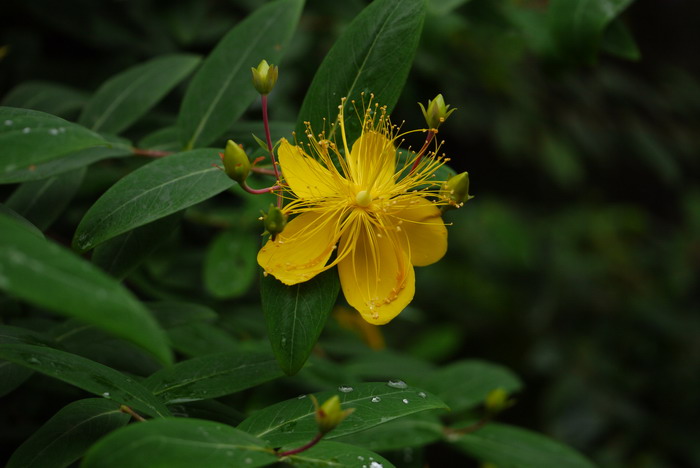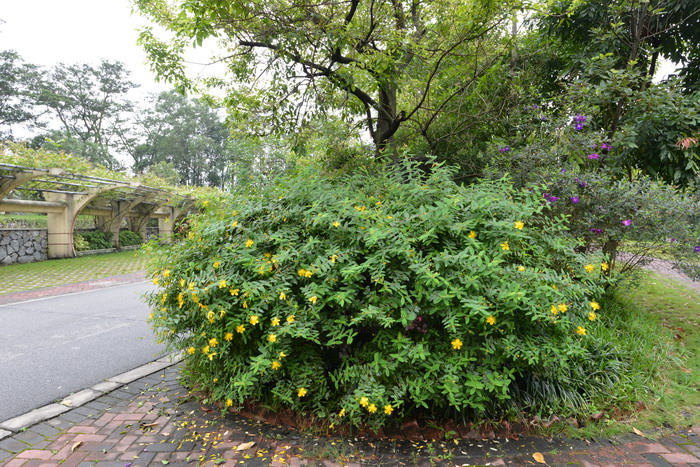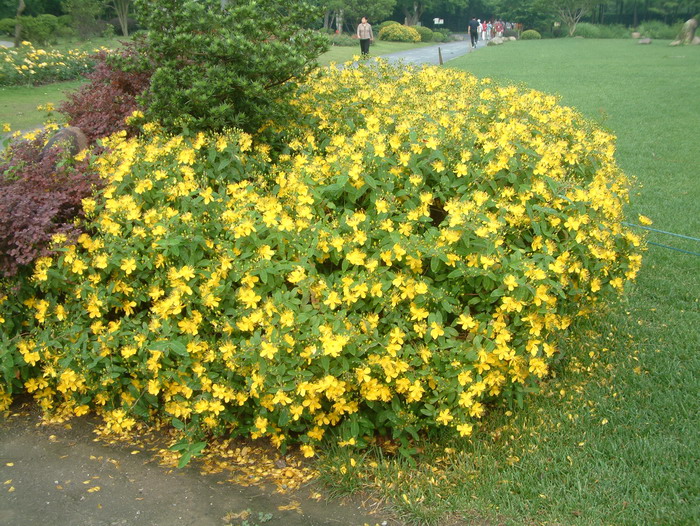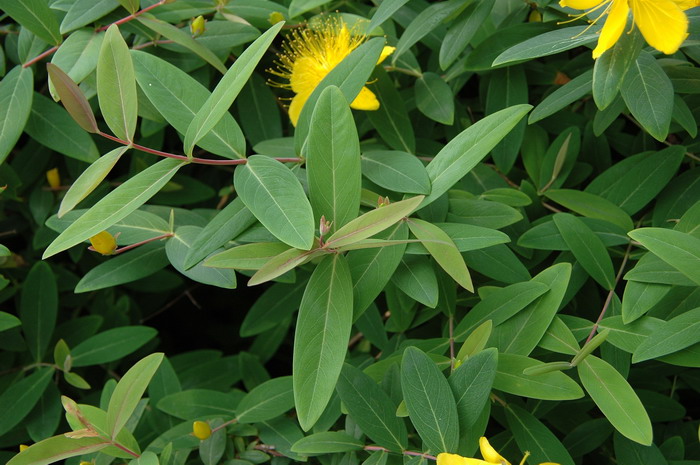金丝桃Hypericum monogynum
中文名(Chinese Name):金丝桃
学名(Scientific Name):Hypericum monogynum Linn.
英文名(English Common Name):
别名(Chinese Common Name):金丝海棠、金丝莲
异名(Synonym):Hypericum chinense var. salicifolium (Siebold et Zucc.) Choisy Hypericum salicifolium Siebold et Zucc. Komana salicifolia (Siebold et Zucc.) Y. Kimura ex Honda Hypericum monogynum var. salicifolium (Siebold et Zucc.) André Hypericum chinense Osbeck Hypericum chinense subsp. latifolium Kuntze Hypericum chinense subsp. obtusifolium Kuntze Norysca salicifolia Blume Norysca chinensis var. salicifolia (Siebold et Zucc.) Y. Kimura Norysca chinensis (L.) Spach Hypericum chinense subsp. salicifolium (Siebold & Zucc.) Kuntze
科属(Family & Genus):藤黄科(Guttiferae)金丝桃属
形态特征(Description):灌木,高0.5-1.3米,丛状或通常有疏生的开张枝条。茎红色,幼时具2(4)纵线棱及两侧压扁,很快为圆柱形;皮层橙褐色。叶对生,无柄或具短柄,柄长达1.5毫米;叶片倒披针形或椭圆形至长圆形,或较稀为披针形至卵状三角形或卵形,长2-11.2厘米,宽1-4.1厘米,先端锐尖至圆形,通常具细小尖突,基部楔形至圆形或上部者有时截形至心形,边缘平坦,坚纸质,上面绿色,下面淡绿但不呈灰白色,主侧脉4-6对,分枝,常与中脉分枝不分明,第三级脉网密集,不明显,腹腺体无,叶片腺体小而点状。花序具1-15(-30)花,自茎端第1节生出,疏松的近伞房状,有时亦自茎端1-3节生出,稀有1-2对次生分枝;花梗长0.8-2.8 (-5 )厘米;苞片小,线状披针形,早落。花直径3-6.5厘米,星状;花蕾卵珠形,先端近锐尖至钝形。萼片宽或狭椭圆形或长圆形至披针形或倒披针形,先端锐尖至圆形,边缘全缘,中脉分明,细脉不明显,有或多或少的腺体,在基部的线形至条纹状,向顶端的点状。花瓣金黄色至柠檬黄色,无红晕,开张,三角状倒卵形,长2-3.4厘米,宽1-2厘米,长约为萼片的2.5-4.5倍,边缘全缘,无腺体,有侧生的小尖突,小尖突先端锐尖至圆形或消失。雄蕊5束,每束有雄蕊25-35枚,最长者长1.8-3.2厘米,与花瓣几等长,花药黄至暗橙色。子房卵珠形或卵珠状圆锥形至近球形,长2.5-5毫米,宽2.5-3毫米;花柱长1.2-2厘米,长约为子房的3.5-5倍,合生几达顶端然后向外弯或极偶有合生至全长之半;柱头小。蒴果宽卵珠形或稀为卵珠状圆锥形至近球形,长6-10毫米,宽4-7毫米。种子深红褐色,圆柱形,长约2毫米,有狭的龙骨状突起,有浅的线状网纹至线状蜂窝纹。染色体2n=42。花期5-8月,果期8-9月。
分布(Distribution):产河北、陕西、山东、江苏、安徽、浙江、江西、福建、台湾、河南、湖北、湖南、广东、广西、四川及贵州等省区。生于沿海海拔1500米以下山坡、路旁或灌丛中。
用途(Use):花美丽,供观赏;果实及根供药用,果作连翘代用品
引自中国植物志英文版FOC Vol. 13 Page 2, 7, 8, 9
Hypericum monogynum Linnaeus, Sp. Pl., ed. 2. 2: 1107. 1763.
金丝桃 jin si tao| Clusiaceae | Hypericum
Hypericum chinense Linnaeus, Syst. Nat., ed. 10, 2: 1184. 1759, not Osbeck (1757), nor Retzius (1788); H. chinense subsp. latifolium Kuntze; H. chinense subsp. obtusifolium Kuntze; H. chinense subsp. salicifolium (Siebold & Zuccarini) Kuntze; H. chinense var. salicifolium (Siebold & Zuccarini) Choisy; H. monogynum var. salicifolium (Siebold & Zuccarini) André; H. salicifolium Siebold & Zuccarini; Komana salicifolia (Siebold & Zuccarini) Y. Kimura ex Honda; Norysca chinensis (Linnaeus) Spach; N. chinensis var. salicifolia (Siebold & Zuccarini) Y. Kimura; N. salicifolia (Siebold & Zuccarini) K. Koch.
Shrubs, 0.5-1.3 m tall, bushy or usually with branches lax, spreading. Stems 2(-4)-lined and ancipitous when young, soon terete; internodes 1-5 cm, shorter than leaves. Leaves with petiole 1.5-2 mm; blade oblong to elliptic, 2.5-5 × 1.2-2.3 cm, thickly papery, abaxially paler but not glaucous; laminar glands very small dots; abaxial glands absent; main lateral veins 2- or 3-paired, all or upper sometimes uniting with midvein branches to form ± arched intramarginal vein, tertiary reticulation very dense, not very conspicuous; base cuneate to subangustate, apex acute to rounded. Inflorescence 1-15(-30)-flowered, from apical node, lax, shallowly round-topped, sometimes also from uppermost 1-3 nodes, rarely with 1 or 2 pairs of flowering branches; bracts caducous, linear-lanceolate, small. Pedicels 0.8-2.8(-5) cm. Flowers 3-6.5 cm in diam., stellate; buds ovoid, apex subacute to obtuse. Sepals ± spreading, broadly to narrowly elliptic or oblanceolate, equal to unequal, 4.5-13 × 1.5-6 mm; laminar glands basally lines to streaks, dots toward apex, margin entire, apex acute to rounded. Petals golden yellow to lemon yellow, triangular-obovate, 2-3.4 × 1-2 cm, 2.5-4.5 × as long as sepals; margin entire, eglandular; apiculus lateral, acute to rounded or obsolete. Stamen fascicles each with 25-35 stamens, longest 1.8-3.2 cm, ca. as long as petals. Ovary ovoid or ovoid-conic to subglobose, 2.5-5 × 2.5-3 mm; styles 1.2-2 cm, 3.5-5 × as long as ovary, united nearly to apices then outcurved or very rarely to half free. Capsule broadly ovoid or rarely ovoid-conic to subglobose, 6-10 × 4-7 mm. Seeds dark reddish brown, ca. 2 mm, narrowly carinate; testa linear-reticulate. Fl. May-Aug, fr. Aug-Sep. 2n = 42*.
● Mountain slopes, roadsides, thickets in dry habitats; sea level to 200 m in lowland provinces, but up to 1500 m in Sichuan. Anhui, Fujian, Guangdong, Guangxi, Guizhou, Henan, Hubei, Hunan, Jiangsu, Jiangxi, Shaanxi, Shandong, Sichuan, Taiwan, Zhejiang [Japan (naturalized); widely cultivated in S Africa, E and S Asia, Australia, Central America, N and W Europe, Mauritius, and the West Indies].
Hypericum monogynum is very variable, but there are no gaps in the variation that would allow infraspecific classification. Four main forms can be recognized:
(i) Leaves elliptic to oblanceolate, base cuneate, apex acute; inflorescence very lax; sepals narrowly elliptic, apex acute ("salicifolium"). W Hubei, Shaanxi, Sichuan.
(ii) Leaves narrowly oblong to lanceolate, base usually rounded, apex obtuse to rounded; inflorescence less lax; sepals narrowly oblong, obtuse ("obtusifolium"). E Hubei and Jiangxi southward and eastward to the coast; Taiwan, where the leaves are oblanceolate.
(iii) Leaves broadly oblong to broadly elliptic or lanceolate, base cuneate to cordate, apex acute to rounded; sepals broadly elliptic to broadly oblong or leaflike ("latisepalum"). W Hubei, Sichuan; also Guizhou and Shandong (probably introduced).
(iv) Leaves broadly elliptic-oblong to triangular-ovate or ovate, base broadly cuneate to rounded, apex obtuse to rounded; sepals narrowly elliptic, apex acute ("ovatum"). Sichuan.



 (责任编辑:徐晔春)
(责任编辑:徐晔春)
学名(Scientific Name):Hypericum monogynum Linn.
英文名(English Common Name):
别名(Chinese Common Name):金丝海棠、金丝莲
异名(Synonym):Hypericum chinense var. salicifolium (Siebold et Zucc.) Choisy Hypericum salicifolium Siebold et Zucc. Komana salicifolia (Siebold et Zucc.) Y. Kimura ex Honda Hypericum monogynum var. salicifolium (Siebold et Zucc.) André Hypericum chinense Osbeck Hypericum chinense subsp. latifolium Kuntze Hypericum chinense subsp. obtusifolium Kuntze Norysca salicifolia Blume Norysca chinensis var. salicifolia (Siebold et Zucc.) Y. Kimura Norysca chinensis (L.) Spach Hypericum chinense subsp. salicifolium (Siebold & Zucc.) Kuntze
科属(Family & Genus):藤黄科(Guttiferae)金丝桃属
形态特征(Description):灌木,高0.5-1.3米,丛状或通常有疏生的开张枝条。茎红色,幼时具2(4)纵线棱及两侧压扁,很快为圆柱形;皮层橙褐色。叶对生,无柄或具短柄,柄长达1.5毫米;叶片倒披针形或椭圆形至长圆形,或较稀为披针形至卵状三角形或卵形,长2-11.2厘米,宽1-4.1厘米,先端锐尖至圆形,通常具细小尖突,基部楔形至圆形或上部者有时截形至心形,边缘平坦,坚纸质,上面绿色,下面淡绿但不呈灰白色,主侧脉4-6对,分枝,常与中脉分枝不分明,第三级脉网密集,不明显,腹腺体无,叶片腺体小而点状。花序具1-15(-30)花,自茎端第1节生出,疏松的近伞房状,有时亦自茎端1-3节生出,稀有1-2对次生分枝;花梗长0.8-2.8 (-5 )厘米;苞片小,线状披针形,早落。花直径3-6.5厘米,星状;花蕾卵珠形,先端近锐尖至钝形。萼片宽或狭椭圆形或长圆形至披针形或倒披针形,先端锐尖至圆形,边缘全缘,中脉分明,细脉不明显,有或多或少的腺体,在基部的线形至条纹状,向顶端的点状。花瓣金黄色至柠檬黄色,无红晕,开张,三角状倒卵形,长2-3.4厘米,宽1-2厘米,长约为萼片的2.5-4.5倍,边缘全缘,无腺体,有侧生的小尖突,小尖突先端锐尖至圆形或消失。雄蕊5束,每束有雄蕊25-35枚,最长者长1.8-3.2厘米,与花瓣几等长,花药黄至暗橙色。子房卵珠形或卵珠状圆锥形至近球形,长2.5-5毫米,宽2.5-3毫米;花柱长1.2-2厘米,长约为子房的3.5-5倍,合生几达顶端然后向外弯或极偶有合生至全长之半;柱头小。蒴果宽卵珠形或稀为卵珠状圆锥形至近球形,长6-10毫米,宽4-7毫米。种子深红褐色,圆柱形,长约2毫米,有狭的龙骨状突起,有浅的线状网纹至线状蜂窝纹。染色体2n=42。花期5-8月,果期8-9月。
分布(Distribution):产河北、陕西、山东、江苏、安徽、浙江、江西、福建、台湾、河南、湖北、湖南、广东、广西、四川及贵州等省区。生于沿海海拔1500米以下山坡、路旁或灌丛中。
用途(Use):花美丽,供观赏;果实及根供药用,果作连翘代用品
引自中国植物志英文版FOC Vol. 13 Page 2, 7, 8, 9
Hypericum monogynum Linnaeus, Sp. Pl., ed. 2. 2: 1107. 1763.
金丝桃 jin si tao| Clusiaceae | Hypericum
Hypericum chinense Linnaeus, Syst. Nat., ed. 10, 2: 1184. 1759, not Osbeck (1757), nor Retzius (1788); H. chinense subsp. latifolium Kuntze; H. chinense subsp. obtusifolium Kuntze; H. chinense subsp. salicifolium (Siebold & Zuccarini) Kuntze; H. chinense var. salicifolium (Siebold & Zuccarini) Choisy; H. monogynum var. salicifolium (Siebold & Zuccarini) André; H. salicifolium Siebold & Zuccarini; Komana salicifolia (Siebold & Zuccarini) Y. Kimura ex Honda; Norysca chinensis (Linnaeus) Spach; N. chinensis var. salicifolia (Siebold & Zuccarini) Y. Kimura; N. salicifolia (Siebold & Zuccarini) K. Koch.
Shrubs, 0.5-1.3 m tall, bushy or usually with branches lax, spreading. Stems 2(-4)-lined and ancipitous when young, soon terete; internodes 1-5 cm, shorter than leaves. Leaves with petiole 1.5-2 mm; blade oblong to elliptic, 2.5-5 × 1.2-2.3 cm, thickly papery, abaxially paler but not glaucous; laminar glands very small dots; abaxial glands absent; main lateral veins 2- or 3-paired, all or upper sometimes uniting with midvein branches to form ± arched intramarginal vein, tertiary reticulation very dense, not very conspicuous; base cuneate to subangustate, apex acute to rounded. Inflorescence 1-15(-30)-flowered, from apical node, lax, shallowly round-topped, sometimes also from uppermost 1-3 nodes, rarely with 1 or 2 pairs of flowering branches; bracts caducous, linear-lanceolate, small. Pedicels 0.8-2.8(-5) cm. Flowers 3-6.5 cm in diam., stellate; buds ovoid, apex subacute to obtuse. Sepals ± spreading, broadly to narrowly elliptic or oblanceolate, equal to unequal, 4.5-13 × 1.5-6 mm; laminar glands basally lines to streaks, dots toward apex, margin entire, apex acute to rounded. Petals golden yellow to lemon yellow, triangular-obovate, 2-3.4 × 1-2 cm, 2.5-4.5 × as long as sepals; margin entire, eglandular; apiculus lateral, acute to rounded or obsolete. Stamen fascicles each with 25-35 stamens, longest 1.8-3.2 cm, ca. as long as petals. Ovary ovoid or ovoid-conic to subglobose, 2.5-5 × 2.5-3 mm; styles 1.2-2 cm, 3.5-5 × as long as ovary, united nearly to apices then outcurved or very rarely to half free. Capsule broadly ovoid or rarely ovoid-conic to subglobose, 6-10 × 4-7 mm. Seeds dark reddish brown, ca. 2 mm, narrowly carinate; testa linear-reticulate. Fl. May-Aug, fr. Aug-Sep. 2n = 42*.
● Mountain slopes, roadsides, thickets in dry habitats; sea level to 200 m in lowland provinces, but up to 1500 m in Sichuan. Anhui, Fujian, Guangdong, Guangxi, Guizhou, Henan, Hubei, Hunan, Jiangsu, Jiangxi, Shaanxi, Shandong, Sichuan, Taiwan, Zhejiang [Japan (naturalized); widely cultivated in S Africa, E and S Asia, Australia, Central America, N and W Europe, Mauritius, and the West Indies].
Hypericum monogynum is very variable, but there are no gaps in the variation that would allow infraspecific classification. Four main forms can be recognized:
(i) Leaves elliptic to oblanceolate, base cuneate, apex acute; inflorescence very lax; sepals narrowly elliptic, apex acute ("salicifolium"). W Hubei, Shaanxi, Sichuan.
(ii) Leaves narrowly oblong to lanceolate, base usually rounded, apex obtuse to rounded; inflorescence less lax; sepals narrowly oblong, obtuse ("obtusifolium"). E Hubei and Jiangxi southward and eastward to the coast; Taiwan, where the leaves are oblanceolate.
(iii) Leaves broadly oblong to broadly elliptic or lanceolate, base cuneate to cordate, apex acute to rounded; sepals broadly elliptic to broadly oblong or leaflike ("latisepalum"). W Hubei, Sichuan; also Guizhou and Shandong (probably introduced).
(iv) Leaves broadly elliptic-oblong to triangular-ovate or ovate, base broadly cuneate to rounded, apex obtuse to rounded; sepals narrowly elliptic, apex acute ("ovatum"). Sichuan.
踩一下[0]

顶一下[3]